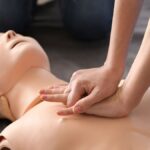Introduction
Cardiopulmonary resuscitation (CPR) is a crucial skill that can make the difference between life and death during emergencies. Whether you’re a healthcare professional, a caregiver, or someone interested in personal safety, learning CPR is vital. However, attending in-person classes may not always be convenient. Fortunately, digital learning platforms offer an effective and flexible solution to mastering CPR skills. In this article, we explore how you can acquire CPR certification online, the benefits of digital learning, and tips for successfully completing your training.
Why Learn CPR Online?
With busy schedules and varied commitments, traditional in-person CPR courses might seem like a time-consuming option. Online CPR certification provides a convenient, accessible alternative that fits into your schedule. Here’s why online CPR courses are an excellent choice:
- Flexibility: Learn at your own pace, on your own time, and from any location.
- Affordability: Online courses are often more affordable than attending in-person training.
- Up-to-Date Content: Online programs are continuously updated to reflect the latest CPR guidelines and techniques.
- Instant Certification: Upon completing the course, you receive your CPR certification instantly, without any delays.
What to Expect from an Online CPR Course
An online CPR course typically includes a combination of video lessons, quizzes, and practical demonstrations. Here’s what you can expect:
- Video Lessons: Watch demonstrations on CPR techniques for adults, children, and infants, as well as information on first aid, choking, and AED (automated external defibrillator) use.
- Interactive Quizzes: Test your knowledge and understanding of the material to ensure you’re prepared for emergency situations.
- Simulations: Some courses include interactive simulations where you can practice your skills virtually, making learning more engaging.
- Practical Skills Assessment: While the theoretical portion is online, you may need to complete a hands-on assessment at an approved location, or in some cases, a video demonstration may be accepted.
The Benefits of Online Learning for CPR
Online CPR certification comes with several advantages, especially in terms of convenience and cost-effectiveness. Consider the following benefits:
- Learn Anytime, Anywhere: You can take the course from the comfort of your home or on the go. Whether you’re at work, at home, or traveling, you can log in and study whenever you have time.
- No Commute: Forget about traveling to a classroom and finding parking. Online courses eliminate the need for commuting, saving you time and money.
- Pacing: With online CPR training, you can move through the content as quickly or slowly as you like, making it easier for you to absorb the information at your own pace.
- Affordable Options: Many online CPR courses are priced competitively, offering great value compared to in-person classes.
Tips for Succeeding in Your Online CPR Course
To ensure that you get the most out of your online CPR certification course, here are some tips to help you succeed:
- Stay Consistent: Set aside time each day to study and complete lessons. Regularly engaging with the material helps reinforce your learning.
- Review Course Materials: Even after completing lessons, review the course materials to refresh your knowledge and practice the techniques.
- Practice with a Partner: Whenever possible, practice CPR skills with a friend or family member to simulate real-life scenarios.
- Take Notes: Writing down key points or concepts can help you remember them better and provide a useful reference as you study.
- Seek Help If Needed: Don’t hesitate to reach out to instructors or fellow students if you have questions or need clarification on any part of the course.
Common Misconceptions about Online CPR Courses
Despite the growing popularity of online learning, some people still doubt the effectiveness of virtual CPR courses. Here are some common misconceptions and the truth behind them:
- Myth: “Online CPR certification isn’t as legitimate as in-person courses.”
- Fact: Many online CPR courses are accredited by reputable organizations, ensuring the certification is recognized by employers and regulatory bodies.
- Myth: “I can’t practice CPR effectively without hands-on training.”
- Fact: While hands-on practice is important, online courses provide valuable demonstrations and simulations to help you understand the correct techniques. Additional in-person sessions may be available for those who wish to further refine their skills.
- Myth: “Online courses are only for beginners.”
- Fact: Online CPR courses cater to all skill levels, from beginners to experienced healthcare professionals, allowing you to refresh or upgrade your CPR skills at any time.
How to Choose the Right Online CPR Course
When selecting an online CPR course, consider the following factors to ensure you’re choosing a reputable and effective program:
- Accreditation: Ensure the course is accredited by recognized organizations, such as the American Heart Association or the Red Cross, for valid certification.
- Course Content: Look for courses that cover essential topics, including adult and pediatric CPR, first aid, AED use, and choking management.
- Instructor Credentials: The instructors should have relevant certifications and experience in teaching CPR and first aid.
- Student Reviews: Check reviews and testimonials from previous students to gauge the quality of the course and its effectiveness.
Conclusion
Mastering CPR skills is an essential investment in both your personal safety and the well-being of others. Online CPR certification offers a flexible, affordable, and effective way to gain these life-saving skills. By selecting the right course, staying consistent, and practicing regularly, you’ll be prepared to act confidently in an emergency. Start learn online CPR journey today and become a vital asset in any emergency situation.






